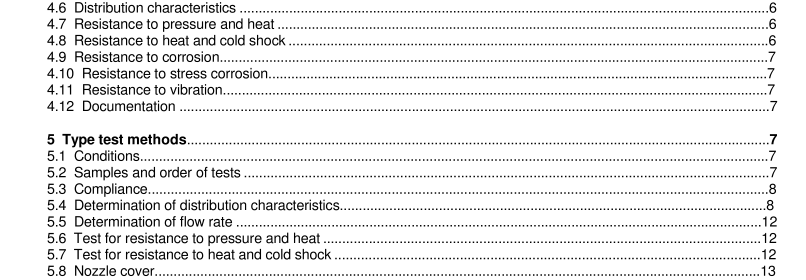BS EN 12094-7:2001 – Fixed firefighting systems Ð Components for gas extinguishing systems Ð

1 Scope
This European Standard specifies requirements and test methods for nozzles that introduce the extinguishing agent into a CO 2 protected zone.
The design of the nozzles will influence discharge rate and thus the pressure drop in the piping network. The extinguishing agent normally arrives at the nozzle in two-phase flow form (liquid-gaseous mixture). It expands into the protected volume to form a gas or a gas-and-dry-ice mixture depending on the nozzle type.
This standard should only be used as guidance for testing nozzles that work on different principles.
2 Normative references
This European Standard incorporates by dated or undated references, provisions from other publications. These normative references are cited at the appropriate places in the text and the publications are listed hereafter. For dated references, subsequent amendments to or revisions of any of these publications apply to this European Standard only when incorporated in it by amendment or revision. For undated references the latest edition of the publication referred to applies (including amendments).
ISO 7-1, Pipe threads where pressure-tight joints are made on the threads — Part 1: Dimensions, tolerances and designation
ISO 228-1, Pipe threads where pressure-tight joints are not made on the threads — Part 1: Dimensions, tolerances and designation
3 Terms and definitions
For the purposes of this European Standard the following terms and definitions apply.
3.1
cross section
total area of all smallest geometrical single areas
3.2
distribution characteristics
volume in which CO 2 is distributed uniformly from a nozzle
3.3
filter
component to prevent blockage of nozzles
3.4
flow rate
mass flow of CO 2 against time
3.5
functional reliability
ability of function under different working conditions
3.6
high pressure container
cylinder filled with CO 2 under ambient temperature conditions
NOTE The pressure at 20 °C is 56,3 bar.
3.7
local application nozzle
nozzle, from which CO 2 is discharged over a partial closed or open hazard
3.8
low pressure container
insulated tank filled with CO 2 equipped with a cooling machine
NOTE The pressure at – 20°C is 18,7 bar.
3.9
nozzle
component to achieve a predetermined flow rate and a uniformed distribution characteristic of the CO 2 into or onto a protected hazard
3.10
nozzle cover
component to protect nozzles against exterior dirt
3.11
resistance coefficient
value for the calculation of the pressure drop in a component under two-phase flow condition
3.12
room protection nozzle
nozzle, from which CO 2 is discharged for distribution throughout an enclosure
3.13
two-phase flow
partial change of phase of a fluid from a liquid to vapour under flowing conditions
3.14
working pressure
pressure at which the component is used in the system
4 Requirements
4.1 General design
The test sample shall comply with the technical description (drawings, parts list, description of functions, operating and installation instructions) when checked in accordance to 5.3.
Metal parts of nozzles shall be made of stainless steel, copper, copper alloy or galvanised steel.
All materials shall be resistant to media with which they come into contact.
Nozzles shall be designed so that the function cannot be adversely affected by ageing or environmental influences.
Non-metallic materials and elastomers shall be selected to be stable and not alter their performance over the working life recommended by the manufacturer.
BS EN 12094-7:2001 – Fixed firefighting systems Ð Components for gas extinguishing systems Ð